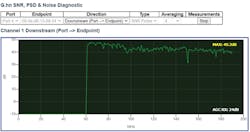MDU Gigabit Speeds Without Compromise
G.hn is an access technology for operators looking to simplify their access network and reduce their costs with an Ethernet-like technology. The ITU-T G.9960 G.hn Wave-2 standard leverages the existing telephone wiring (UTP, CAT-3 or CAT 5/5e) or RG-6/RG-59 coax cabling (each coax port serves up to 16 subscribers) to deliver a gigabit Internet service to each apartment inside a Multi-Dwelling Unit (MDU) or Multi-Tenant Unit (MTU) without the cost, complexity, and delays, associated with in-building fiber installation.
With G.hn, operators deliver advanced services, such as gigabit high-speed residential Internet and 4K Internet Protocol television (IPTV) without the high capital and operational expenses associated with a fiber retrofit. Each G.hn subscriber port supports up to 1.7 Gbps of dynamically allocated bandwidth for near-symmetrical gigabit services. A G.hn Access Multiplexer (GAM) then connects to and extends multi-gigabit feeds from fiber terminating in the GAM via an ONT (Optical Network Terminal xPON) or fixed wireless access radios. It serves all residential gateways with gigabit Ethernet router ports using G.hn.
G.hn and CATV Spectrum
When operating over Coax, G.hn uses baseband spectrum from 5-200 MHz. Unlike Data Over Cable Service Interface Specifications (DOCSIS), G.hn dynamically allocates each tone to carry either upstream or downstream traffic to reflect the demand from the subscribers, achieving gigabit speeds in both directions.
The base definition of DOCSIS 3.1 allocates the 5-42 MHz range to upstream traffic, resulting in "up to" 100 Mbps of shared bandwidth across all subscribers on a Cable Modem Termination System (CMTS) port. DOCSIS vendors have recently introduced solutions to provide more upstream bandwidth by extending the spectrum for the upstream bands by reducing the spectrum used for the downstream direction. Two split levels are defined as per Figure 1.
Figure 1 shows the Mid-Split approach extends the upstream spectrum to 5-85 MHz, resulting in about 500 Mbps. The High-Split approach extends the spectrum to 5-204 MHz for about 1.5 Gbps of throughput. A DOCSIS network is engineered to serve an average of 150 subscribers on the premises in which the peak use per subscriber is well below 5 Mbps downstream and below 350 Kbps (not Mbps) upstream. With the increase in bandwidth consumption for teleworking and remote learning, this no longer reflects the usage patterns we experience in 2021.
Looking at the G.hn spectrum, we see that the 5-200 MHz range handles upstream and downstream traffic using an Orthogonal Frequency-Division Multiplexing (OFDM) encoding. (See Figure 2.) (This is somewhat different than with DOCSIS where the upstream is encoded with OFDM and the downstream uses Orthogonal Frequency-Division Multiple Access (OFDMA)). The aggregate bandwidth of G.hn on coax is 1.7 Gbps (or 2 Gbps at the physical layer).
Before jumping to the conclusion that a High-Split approach offers more bandwidth than G.hn, it is important to remember that each coax port of a GAM can serve up to 16 subscribers (not several hundred as is the case with DOCSIS). This easily handles a peak average of 100 Mbps (dynamically split between upstream and downstream for each subscriber) and allows for peaks at 1 Gbps without problem. A 24-port GAM device, like the one Positron offers, can deliver 40 Gbps of capacity inside an MDU, with the actual total bandwidth being constrained by the available fiber link. For instance, the GAM would be able to handle the same bandwidth as four (4) 10GEPON or XGS-PON links. That means, the GAM will not be a limiting factor to extend the fiber service over the coaxial infrastructure of a building.
Coexistence With CATV
With DOCSIS High-Split, the Community Antenna Television (CATV) channels are allocated from 258 MHz (channel 30), and the total downstream spectrum available and bandwidth achievable is a function of the number of channels offered to subscribers. The more channels, the less spectrum remains for the downstream traffic. For instance, 20 CATV channels, each using 6 MHz of spectrum, reduce the downstream bandwidth of DOCSIS by about 1 Gbps.
Like the DOCSIS High-Split, G.hn allows CATV channels starting at 258 MHz. The very important difference and benefit of G.hn is that it does not use any spectrum that overlaps with the CATV content. Therefore, the total available bandwidth of G.hn is not impacted by the number of channels offered to the subscribers.
When deploying a GAM in environments such as an MDU or a hotel, it is very easy to overlay the G.hn and CATV signals over the same coaxial cabling using standard splitters-combiners as shown in Figure 3.
Looking at Figure 3, we see that the CATV signal needs to be overlaid with G.hn for each port of a GAM device. This combined G.hn + CATV signal can then feed up to 16 subscribers per GAM port using standard splitter devices that are typically already in place. A single coaxial drop per apartment or guest room is then used to bring the G.hn signal to a G.hn endpoint (Ethernet bridge) and to a set-top-box or TV.
Adding Pay-Per-View
Pay-per-View services rely on return channels located below the 50 MHz range. The specific channel(s) may vary depending on the Pay-per-View solution in use. To make room for such signals, a G.hn signal can be "notched" to begin at a higher frequency than the default 5 MHz defined by the G.hn standard (ITU-T G.9660). This is achieved via a simple configuration setting in the GAM. While this reduces the available spectrum, it does not prevent G.hn from delivering peak bandwidth of 1 Gbps in any direction.
For example, a GAM can configure the G.hn signal to begin at 60 MHz. Looking at Figure 4, we clearly see that the Power Spectral Density (PSD) for the G.hn signal is from 60 MHz to 200 MHz on the G.hn port using the coaxial cable.
Simple Migration to IPTV
The migration to IPTV is gaining momentum, even for traditional cable operators. G.hn offers a seamless migration to IPTV, and does not require all subscribers to switch at the same time; this is achieved via a simple 2-step approach.
Step 1. Inject the IPTV feed via the uplink port of a GAM. The GAM provides full support for Internet Group Management Protocol (IGMP) Multicasting, allowing multiple subscribers to share the same IPTV feed, which is very convenient for serial TV. At the same time, the GAM supports unicast IPTV which allows for more advanced user experiences (pause, rewind) without additional complexity.
Step 2. Whenever a subscriber is ready to migrate to IPTV, use the second Gigabit Ethernet port of the G.hn endpoint and connect it to the set-top-box or smart TV. You can then disconnect the coax cable from that previously used for the CATV signal.
Once there are no remaining CATV subscribers on a coaxial segment, remove the spectrum notch (5-60 MHz in the example earlier) to reclaim the full G.hn spectrum to deliver the full 1.7 Gbps of aggregate bandwidth of G.hn.
Conclusion
G.hn optimizes the spectrum use on coaxial cabling to achieve superior bandwidth to DOCSIS in the upstream and downstream directions. G.hn is an ideal fiber extension. (See the Broadband Forum TR-419 document for more information about the concept of Fiber to the Extension point.) It further shares the coaxial cabling with legacy cable TV (CATV), and facilitates a simple and efficient migration to IPTV.
For more information, please email [email protected] and visit https://www.positronaccess.com/. Follow us on Twitter at https://twitter.com/PositronAccess. Social media handles: #ghn #GAM #telecoms #fiberextension #MDU.
About the Author





